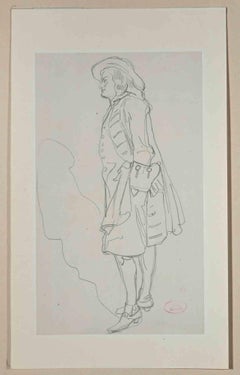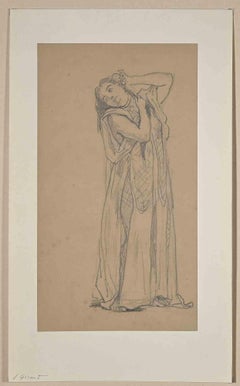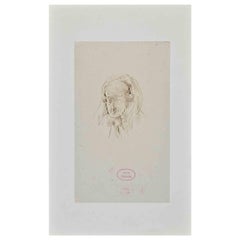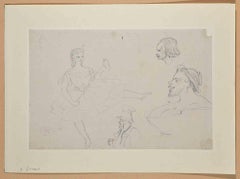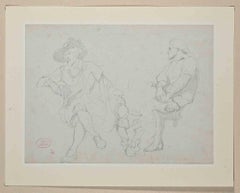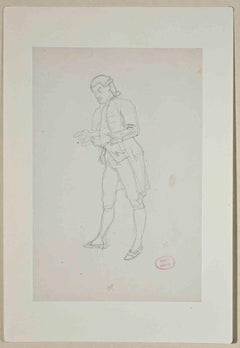Eugène Giraud Portrait Drawings and Watercolors
French, 1806-1881
Pierre François Eugène Giraud was a French painter and engraver. Giraud painted one of the best-known portraits of the French writer Gustave Flaubert. He was a pupil of Hersant and won many awards and honors in recognition for his work and production. Giraud was Prix de Rome in 1826 and Legion of Honor in 1851.
to
1
7
Overall Width
to
Overall Height
to
7
7
5
2
7
6
5
4
3
2
1
6
1
1
19
199
72
60
51
Artist: Eugène Giraud
Gentleman - Original Drawing in Pencil by Eugène Giraud - Late 19th Century
By Eugène Giraud
Located in Roma, IT
Gentleman is an Original Drawing in pencil realized by Eugène Giraud in the Late 19th Century.
Applied on a Cardboard, included a blue Passepartout: 41 x 33 cm
Good conditions. Sta...
Category
Late 19th Century Modern Eugène Giraud Portrait Drawings and Watercolors
Materials
Pencil
Young Lady - Original Drawing in Pencil by Eugène Giraud - Late 19th Century
By Eugène Giraud
Located in Roma, IT
Young Lady is an Original Drawing in pencil realized by Eugène Giraud in the Late 19th Century.
Applied on a Cardboard, included a blue Passepartout: 41 x 33 cm
Good conditions.
T...
Category
Late 19th Century Modern Eugène Giraud Portrait Drawings and Watercolors
Materials
Pencil
Portrait of an Old Woman - Original Drawing by E. Giraud - Late 19th Century
By Eugène Giraud
Located in Roma, IT
Portrait of an Old Woman is an Original Drawing in ink realized by Eugène Giraud in the Late 19th Century.
Applied on a Cardboard.
Stamped on the lower right.
Good conditions.
Th...
Category
Late 19th Century Modern Eugène Giraud Portrait Drawings and Watercolors
Materials
India Ink
Figures - Original Drawing in Pencil by Eugène Giraud - Late 19th Century
By Eugène Giraud
Located in Roma, IT
Figures is an Original Drawing in pencil realized by Eugène Giraud in the Late 19th Century.
Applied on a Cardboard, included a blue Passepartout: 41 x 33 cm
Good conditions with a...
Category
Late 19th Century Modern Eugène Giraud Portrait Drawings and Watercolors
Materials
Pencil
Gentlemen - Original Drawing in Pencil by Eugène Giraud - Late 19th Century
By Eugène Giraud
Located in Roma, IT
Gentlemen is an Original Drawing in pencil realized by Eugène Giraud in the Late 19th Century.
Applied on a Cardboard, included a blue Passepartout: 33 x 41 cm.
Good conditions.
T...
Category
Late 19th Century Modern Eugène Giraud Portrait Drawings and Watercolors
Materials
Pencil
Gentleman - Original Drawing in Pencil by Eugène Giraud - Late 19th Century
By Eugène Giraud
Located in Roma, IT
Gentleman is an Original Drawing in pencil realized by Eugène Giraud in the Late 19th Century.
Applied on a Cardboard, included a blue Passepartout: 41 x 33 cm.
Stamped on the lowe...
Category
Late 19th Century Modern Eugène Giraud Portrait Drawings and Watercolors
Materials
Pencil
The Maidservant - Original Drawing in Pencil by E. Giraud - Late 19th Century
By Eugène Giraud
Located in Roma, IT
The Maidservant is an Original Drawing in pencil realized by Eugène Giraud in the Late 19th Century.
Applied on a Cardboard, included a blue Passepartout: 41 x 33 cm
Good condition...
Category
Late 19th Century Modern Eugène Giraud Portrait Drawings and Watercolors
Materials
Pencil
Related Items
"Contemplation"
By Gershon Benjamin
Located in Lambertville, NJ
Jim’s of Lambertville is proud to offer this artwork by:
Gershon Benjamin (1899-1985)
An American Modernist of portraits, landscapes, still lives, and the urban scene, Gershon Benj...
Category
1920s Modern Eugène Giraud Portrait Drawings and Watercolors
Materials
Graphite
Head of a Young Girl - Kiki de Montparnasse
By Léonard Tsuguharu Foujita
Located in Miami, FL
Léonard Tsugouharu FoujitaFujita Tsuguharu?, November 27, 1886 – January 29, 1968) was a Japanese–French painter and printmaker born in Tokyo, Japan who applied Japanese ink techniqu...
Category
1920s Post-Impressionist Eugène Giraud Portrait Drawings and Watercolors
Materials
India Ink
$90,000
H 9.25 in W 7.38 in
A Handsome 1940s Portrait of a Seated Man by Chicago Artist, Harold Haydon
By Harold Haydon
Located in Chicago, IL
A Handsome 1940s Portrait of a Seated Man by Chicago Modern Artist, Harold Haydon (Am. 1909-1994). A wonderfully executed line drawing dating from 1946 with great character; looks ...
Category
Mid-20th Century American Modern Eugène Giraud Portrait Drawings and Watercolors
Materials
Paper, Graphite
$135
H 20 in W 16 in D 0.13 in
Young man in a toga elegant man Latin American hyperrealist Hockney style
By Claudio Bravo
Located in Norwich, GB
Superb original drawing in coloured conté pencils, heightened with white on oatmeal coloured vergé paper by Claudio Bravo. The work was created during the artist's Moroccan period, a...
Category
1970s Modern Eugène Giraud Portrait Drawings and Watercolors
Materials
Conté, Laid Paper, Color Pencil
$7,500
H 30.32 in W 24.02 in D 0.4 in
Alfred Bendiner, (Baseball Hitter and Pitcher -- The Philadelphia Phillies?)
By Alfred Bendiner
Located in New York, NY
Of course it's possible that these baseball players aren't from a Philadelphia team, but I doubt it. There was so much drama and intrigue with both the Philadelphia Phillies...
Category
Mid-20th Century American Modern Eugène Giraud Portrait Drawings and Watercolors
Materials
India Ink, Watercolor
African Mama - Vintage Illustration in Ink and Watercolor
By Irene Pattinson
Located in Soquel, CA
African Mama - Vintage Illustration in Ink and Watercolor
A charming illustration, by Irene Pattinson (American, 1909-1999), shows a woman with a...
Category
1950s American Modern Eugène Giraud Portrait Drawings and Watercolors
Materials
Paper, India Ink, Watercolor, Pen
$795
H 13 in W 10 in D 0.25 in
Abutilon Auicennae (drawing paper botany nostalgic lady chignon hair bun plants
By Rudolf Kosow
Located in Quebec, Quebec
keywords; surrealism, portrait, oil painting, earth tones, figurative painting, strangeness, contemporary surrealistic, unsettling, contemporary figurative painting, dreams, symbolic composition, dream, flesh tones, portrait, earth tones, tonalist, nostalgia, early 20th century, naturalist, illustration, grey art, young woman, hair, hair bun...
Category
2010s Jugendstil Eugène Giraud Portrait Drawings and Watercolors
Materials
Color Pencil, Paper
$810
H 16.54 in W 11.62 in D 0.08 in
1940s Charcoal and Pencil Portrait of a Man
Located in Arp, TX
Artist Unknown
"Tie and Glasses"
c. 1940s
Charcoal and pencil on paper
13.5"x17" site 19"x23" rustic wood frame
Unsigned
Category
1940s Modern Eugène Giraud Portrait Drawings and Watercolors
Materials
Paper, Charcoal, Carbon Pencil
19th C. Newspaper Illustration of Hiram H. Hobbs, Foreman of the Grand Jury 1898
Located in Soquel, CA
Historical late 19th century portrait of Hiram H. Hobbs, Foreman of the Grand Jury of San Francisco y Richard Langtry Partington (American, ...
Category
1890s American Impressionist Eugène Giraud Portrait Drawings and Watercolors
Materials
India Ink, Illustration Board
$636 Sale Price
20% Off
H 9 in W 7 in D 0.25 in
A Sensitive 1950s Mid-Century Modern Portrait of a Young Man By Harold Haydon
By Harold Haydon
Located in Chicago, IL
A Sensitive, Finely Rendered 1950s Mid-Century Modern Portrait of a Young Man By Noted Chicago Artist, Harold Haydon (Am. 1909-1994). Artwork size: 12 x 9 1/2 inches. Artwork is un...
Category
Mid-20th Century American Modern Eugène Giraud Portrait Drawings and Watercolors
Materials
Paper, Graphite
$385
H 16 in W 12 in D 0.13 in
The Parade of Fairground Wrestlers, Modern French School
Located in London, GB
'The Parade of Fairground Wrestlers', India ink on art paper, Modern French School (early 1900s). Traveling shows often held promotional events before opening in local areas to generate enthusiasm for the spectacle. This is an intriguing depiction of the various acts on stage strutting their stuff before an audience of potential customers. On the platform, fairground wrestlers mix with clowns, dancers, a percussionist in bolero hat...
Category
Early 20th Century Modern Eugène Giraud Portrait Drawings and Watercolors
Materials
Paper, India Ink
$377 Sale Price
50% Off
H 14.18 in W 14.18 in
beggars spanish modernism colored pencils
By Ricard Opisso Sala
Located in Sitges, Barcelona
Ricard Opisso - Beggars - Colored pencils
Measurements drawing 21x31cm.
Frame measures 39x48 cm.
Damaged paper at bottom.
Anti-reflective glass.
Son of Alfredo Opisso y Viñas, journalist, historian and critic, and of Antonia Sala y Gil, his sister Regina Opisso, was also a writer. He comes from an enlightened family full of artists. His paternal grandfather was Josep Opisso y Roig, journalist and director of the Diari de Tarragona, father of the also writers Antonia Opisso y Viña and Antoni Opisso y Viña. His maternal great-grandfather was the painter Pere Pau Montaña, his maternal grandfather the fabulist Felipe Jacinto Sala and his maternal uncle, the painter Emilio Sala y Francés. His nephew was Arturo Llorens y Opisso, a writer better known under his pseudonym Arturo Llopis.
Although he was born in Tarragona, his family moved to Barcelona when Opisso was only two years old. In modernist Barcelona at the end of the 19th century, Opisso worked as an assistant to Antonio Gaudí in the works of the Sagrada Familia in Barcelona since 1892. He was linked to the group Els Quatre Gats, along with Ramón Casas...
Category
1940s Modern Eugène Giraud Portrait Drawings and Watercolors
Materials
Color Pencil
$2,394 Sale Price
44% Off
H 8.27 in W 12.21 in
Eugène Giraud portrait drawings and watercolors for sale on 1stDibs.
Find a wide variety of authentic Eugène Giraud portrait drawings and watercolors available for sale on 1stDibs. You can also browse by medium to find art by Eugène Giraud in pencil, india ink, ink and more. Much of the original work by this artist or collective was created during the 19th century and is mostly associated with the modern style. Not every interior allows for large Eugène Giraud portrait drawings and watercolors, so small editions measuring 6 inches across are available. Customers who are interested in this artist might also find the work of Georges Gobo, Alfred Grevin, and Serge Fontinsky. Eugène Giraud portrait drawings and watercolors prices can differ depending upon medium, time period and other attributes. On 1stDibs, the price for these items starts at $165 and tops out at $321, while the average work can sell for $165.
